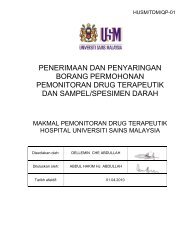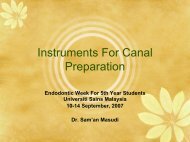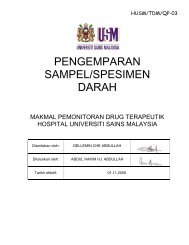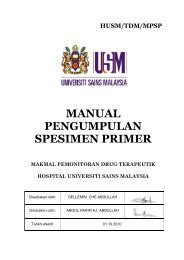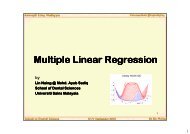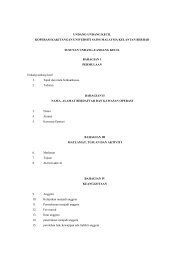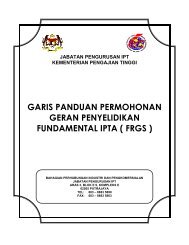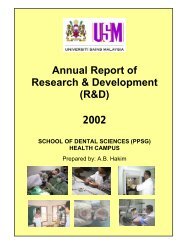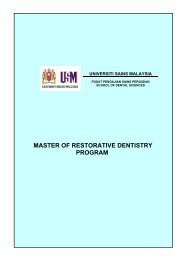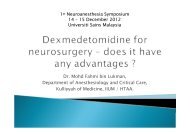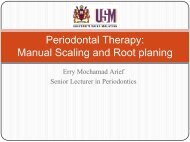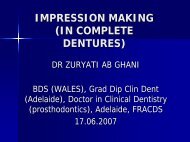PRINCIPLES OF ADHESION
PRINCIPLES OF ADHESION
PRINCIPLES OF ADHESION
Create successful ePaper yourself
Turn your PDF publications into a flip-book with our unique Google optimized e-Paper software.
<strong>PRINCIPLES</strong> <strong>OF</strong><br />
<strong>ADHESION</strong><br />
DR ZURYATI AB GHANI<br />
BDS (WALES), Grad Dip Clin Dent<br />
(Adelaide), Doctor in Clinical Dentistry<br />
(Prosthodontics), Adelaide, FRACDS<br />
(Australia).<br />
22.10.07
Lecture Content<br />
<strong>PRINCIPLES</strong> <strong>OF</strong> <strong>ADHESION</strong><br />
• Types of adhesion<br />
• Development of adhesion in dentistry<br />
• Advantages of adhesive in dentistry<br />
<strong>ADHESION</strong> TO ENAMEL AND DENTINE<br />
• Adhesion to enamel<br />
• Adhesion to dentine
Adhesion<br />
• Adhesion / bonding - The joining together of<br />
two objects using glue or cement.<br />
• All dental materials must function in a wet,<br />
hostile environment<br />
• The oral environment limit the types of<br />
adhesives used in dentistry
ADHERENT<br />
Resin Composite<br />
Ceramic, Acrylic<br />
ADHESIVE<br />
Adhesive resin<br />
Silane primer,<br />
tin plating<br />
ADHEREND<br />
Enamel, dentine,<br />
Alloy, ceramic<br />
Dr T. Berekallly
Types of adhesion/bonding<br />
• Macro-mechanical<br />
• Micro-mechanical<br />
The glue or cement flows<br />
into surface irregularities.<br />
The set cement is locked<br />
into the surface<br />
irregularities of the objects<br />
being joined<br />
• Interfacial/Chemical Adhesion<br />
• True adhesion
Macro-mechanical<br />
• Bonding using surface irregularities where<br />
surface roughness can be seen or felt.<br />
• Screws, nuts, bolts, glues join two pieces of<br />
woods<br />
• In dentistry- cementation of crown or bridges to<br />
teeth with ‘non adhesive cement’<br />
• Disadvantage- stress is concentrated in the<br />
vicinity of the fastener
Macro-Mechanical Mechanical Adhesion<br />
• Visible interlocking between<br />
dissimilar materials<br />
• Acrylic facings on alloy<br />
subframes for bridges<br />
• Removable partial dentures<br />
• Overlay dentures<br />
• Implant-supported prostheses<br />
Dr T. Berekally
Dr T. Berekally<br />
Rochette Bridge
Dr T. Berekally
Micro-mechanical adhesion<br />
• Bonding using surface irregularities smaller than<br />
can be seen with naked eye or felt with the<br />
dental explorer.<br />
• Increased number of surface irregularities are<br />
used thus forces are distributed evenly.<br />
• Stronger than macro-mechanical mechanical adhesion.
Micromechanical Adhesion<br />
• Microscopic mechanical interlocking<br />
between dissimilar materials<br />
• Resin composite<br />
• Amalgam bonding<br />
• Resin-bonded ceramics<br />
Dr T. Berekally
Maryland Bridge<br />
Etching Units<br />
SEM Etched Rexillium III<br />
Dr T. Berekally
Surface Coatings Enhancing Adhesion<br />
• Sandblasting with alumina oxide (Micro-Etcher Danville<br />
Engineering))<br />
• Silica oxide coating (Silicoater: Kulzer;Rocatec ® ESPE)<br />
• Porous metal coatings (INZOMA P990)<br />
• Tin plating (Kura Ace, EX Oxisor, , Micro Tin*)
Surface Preparation of Indirect Resins for<br />
Cementation: Rocatec ®<br />
Al 2 O 3<br />
Dr T. Berekallly<br />
High temperature fuses<br />
SiO 2 to resin surface
Interfacial/ Chemical Adhesion<br />
CERAMIC<br />
Resin Cement<br />
Silane layer<br />
ENAMEL<br />
Berekally
True/chemical adhesion<br />
• Involves chemical bonds between the materials<br />
being joined<br />
• Bonding of GIC to tooth structure
Advantages of adhesive in dentistry<br />
• Retention of restoration<br />
No need to use undercut or mechanical lock<br />
• Conservation of tooth structure<br />
• Reduction in microleakage- ↓post operative<br />
sensitivity, ↓ stain<br />
• Reduction in recurrent caries<br />
• Reinforcement of tooth structure<br />
• Repair of restorations
Development of adhesive materials<br />
• 1950’s s Michael Buonocore introduced acid etcing to create<br />
micromechanical retention for pit and fissure sealants<br />
• 1960’s s composite restoration was developed<br />
• 1970’s-1980<br />
1980’s- many other composite materials developed<br />
with acid etching technique:<br />
ortho brackets<br />
Etch the metal part of bridge and bond it to tooth.<br />
Plastic/composite/porcelain veneers bonded to labial tooth<br />
surface of tooth to hide discolouration/ / close space<br />
Periodontal splint<br />
ACID ETCHING COMPOSITE IS ‘GOLD STANDARD’<br />
<strong>OF</strong> ADHESIVE DENTISTRY.
Chemical adhesion<br />
• 1970’s- Polycarboxylate cement was introduced<br />
• GIC introduced by Wilson, Cusp and McLean<br />
• BUT- lack aesthetic and mechanical toughness<br />
of compared to composite
Factors affecting boding to tooth<br />
structure<br />
• Surface factors<br />
- Clean surface<br />
- Compatible surface for increased surface<br />
wetting<br />
• Biofilms<br />
- Enamel pellicle decreased bonding<br />
- The need to use rubber dam
A<br />
θ 1<br />
θ 2<br />
B<br />
B = Material has superior wetting, a desirable property
Adhesive Failure<br />
ADHERENT<br />
Adhesive Resin<br />
ADHEREND<br />
Berekally
Berekally<br />
Resin Fracture in Maryland Bridge Pontic<br />
OR = Opaquer Resin<br />
RB = Metal Beads for resin retention
Cohesive Failure<br />
A<br />
B<br />
A<br />
Failure within material<br />
A<br />
Failure in adhesive layer<br />
Berekally
<strong>ADHESION</strong> TO ENAMEL<br />
AND DENTINE
Enamel Composition<br />
• 95-98% by weight inorganic component<br />
(hydroxyapatite)<br />
• Crystalline structure is fairly constant at different<br />
levels<br />
• Minor organic components<br />
• Water (very low percentage)
Adhesion to Enamel<br />
• Etching of enamel with 37% orthophosphoric acid for 15-<br />
30 secs produce micropores.<br />
• 30 – 40% phosphoric acid removes about 10mm of the<br />
enamel surface<br />
• A low viscosity liquid polymer (bonding resin) applied<br />
and flows into microscopic irregularities and set,<br />
producing RESIN TAGS<br />
• Then layers of restorative materials bond to this bonding<br />
resin<br />
• Bond strength→ 20-25<br />
25 mPa<br />
• Simple and strong adhesion<br />
• Initially used in fissure sealant
Enamel: Etching Pattern<br />
Type 1 Type 3<br />
Type 2<br />
Summit et al, 2001
Factors Influencing Type of<br />
Etched Surface<br />
• Type of etchant (organic/ inorganic acid)<br />
• Etchant concentration<br />
• Etching time<br />
• Gel versus liquid etchant<br />
• Enamel instrumentation after etching<br />
• Tooth type (deciduous/ adult)<br />
• Prismless enamel<br />
• Presence of contaminants<br />
• Status of the enamel (fluorosis(<br />
fluorosis, hypoplasia,<br />
staining, amelogenesis imperfecta)
Adhesion to Dentine<br />
• A typical cavity preparation has more dentine<br />
available for bonding than enamel<br />
Dentine content<br />
Inorganic 72%<br />
Organic 18%<br />
Water 10%
Problems in Dentine Bonding<br />
• Dentine structure is more complex and variable<br />
than enamel<br />
• Odontoblastic processes are mostly water<br />
• 1°, , 2°, 2 , reparative, sclerotic dentine and dead<br />
tracts<br />
• Smear layer-extend extend to dentinal tubules
Dentine Tubule Distribution<br />
Multizoned Carious Lesion<br />
Outer Occlusal dentine<br />
Reparative<br />
Dentine<br />
Erosion<br />
PULP<br />
Inner Occlusal Dentine<br />
Reactive Dentine (erosion,<br />
abrasion)<br />
Physiologic Dentine (aging, wear)<br />
Many Occluded Tubules
Dentine Bonding System<br />
• Bond to both enamel and dentine<br />
• Historically- enamel etched, washed, dried.<br />
Then dentine conditioned with chelating agent<br />
or EDTA to remove smear layer. Primer<br />
applied, followed by adhesive, then composite.<br />
• Now- 3 steps, 2 steps or 1 step
3 Steps Dentine Bonding<br />
1. Etch enamel and dentine with 37%<br />
orthophosphoric acid.<br />
(Etched dentine- smear layer removed, surface<br />
disinfected, decrease fluid oozing from<br />
odontoblast, , decalcify dentine a few micron<br />
thick)<br />
• Rinse with water<br />
• Slightly dry with gentle air stream or blot dry
Collagen Fibres<br />
Smear Layer<br />
Demineralised Zone<br />
Peritubular dentine<br />
Summit et al, 2002
2. Apply primer,<br />
• Primer is a wetting agent that aids adhesive in<br />
flowing into dentinal tubules around collagen.<br />
• Contains volatile solvents such as acetone.<br />
• Hydrophilic<br />
3. Apply adhesive, light cure.<br />
Place composite
Hybrid Layer Formation in Dentine<br />
ADHESIVE RESIN<br />
Hybrid<br />
Zone<br />
ETCHANT PRIMER<br />
Intertubular<br />
Dentine<br />
Berekally<br />
Peritubular<br />
Dentine<br />
Dentinal Tubules
Hybrid Layer in Dentine Bonding<br />
Adhesive<br />
Hybrid layer<br />
Lateral canal<br />
Intertubular dentine<br />
Peritubular dentine<br />
Resin tag<br />
Summit et al, 2001
Dentine Bonding<br />
• Resin tags in dentinal tubules- Micromechanical<br />
• Hybrid layer<br />
- Adhesive resin interlocks with the dentinal<br />
collagen (micromechanical)<br />
- There are a small number of amino acids which<br />
are available for chemical reactions (eg;<br />
dicarboxylic acids, arginine, lysine)<br />
- Attempts to measure the chemical bond<br />
strengths have been up to now been<br />
unsuccessful
2 steps<br />
i) – Etch (smear layer removed)<br />
-Primer + Adhesive<br />
ii) - Etching primer (smear layer altered)<br />
-Adhesive<br />
1 step<br />
Etch, primer, adhesive in one bottle<br />
Smear layer altered
Smear layer<br />
• A layer of dentine, enamel shavings, organic<br />
matter, bacteria, blood products crevicular fluid<br />
and saliva which is formed during cavity<br />
preparation<br />
• Bond strength to tooth structure ~ 2-2<br />
3 MPa<br />
• Can be altered or removed because it is not a<br />
very stable adhesion interface
Dry vs wet bonding<br />
Dry<br />
Wet<br />
Summit et al, 2001
Summary<br />
• There are macromechanical, , micromechanical,<br />
and chemical adhesion/bonding.<br />
• Adhesion used in all aspects of dentistry-<br />
retention of restoration, fixed and removable<br />
prosthetics, orthodontics and aesthetic dentistry.<br />
• Bonding to enamel is simple, but not dentine.<br />
• Therefore dentine bonding system was<br />
introduced. The system either by removing or<br />
altering smear layer.
REFERENCES<br />
• Clinical Aspects of Dental Materials. M Gladwin, M<br />
Bagby. . 2000. Lippincott, Williams & Wilkins.<br />
Baltimore, USA<br />
• Dr Tom Berekally’s Lectures: Adhesion Systems (Part<br />
1, Part 2). Consultant prosthodontist, , University of<br />
Adelaide, South Australisa.<br />
• Introduction to Dental Materials. R van Noort. . 2002.<br />
Mosby. Edinburgh.<br />
• Fundamentals of Operative Dentistry. A Contemporary<br />
Approach. JB Summit, JW Robbins, RS Schwarts. . 2001,<br />
Qiuntessence Publishing Co, Inc. Chicago.



